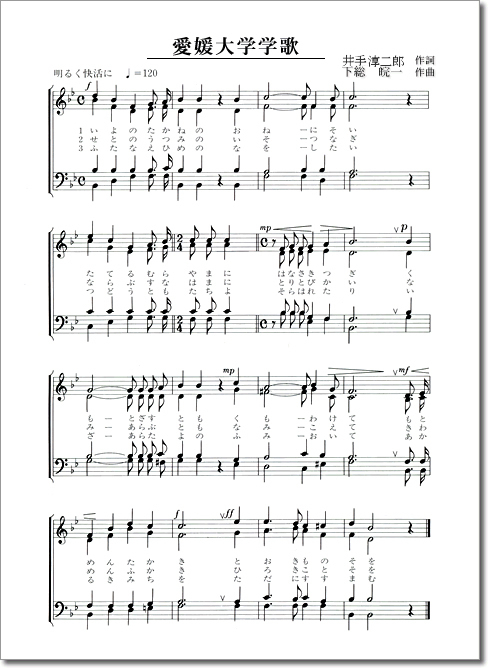school song
Lyrics: Junjiro Ide, music: Kenichi Shimofusa
- Along the ridge of Iyo’s high peak
A flower blooms and blooms again in a cluster of standing mountains
Even if the clouds are closed, the clouds will part
Seek that which is high and far away - Isozaki, the rocky shore of the Inland Sea of Seto.
Birds fly over the sandy beach in a row
Wave after wave
I shall study the profound and the profoundly knowledgeable. - Two names are given the name of Ehime.
The sky is clear, my friends.
Now, let’s get on with the new generation’s work.
I’ll just go down the bright road.
Click here to download
Music data linked from this page is for private use only.
Materials
~ Excerpt from the October 1997 issue of the academic bulletin (digest No. 409) ~.
From the 50th Anniversary Editorial Office: The History of Ehime University (9) – The High Peaks of Iyo
Origin of the school song
The flowers bloom and grow on the mountain ridges of Iyo’s lofty peaks. ???? This is the Ehime University academic song that everyone knows well. It is always sung at university entrance ceremonies and graduation ceremonies, but I think that most of us rarely think about the content of the school song. In this article, I would like to discuss the university song, which is the symbol of Ehime University along with the university emblem and the university flag.
First, when was the school song created? The article “Call for School Song” was published in the school bulletin No. 29 dated June 30, 1952 (Showa 27, 1952). Applicants must be faculty, staff, and students of the university (including affiliated schools). The lyrics should be clearly recognizable as the University’s song, as plain as possible, and enjoyable to sing. The Japanese language classes of the Faculty of Arts and Sciences and the Faculty of Education will be in charge of the judging, and one winning entry will receive a cash prize of 2,000 yen, and two honorable mentions will receive a cash prize of 1,000 yen each. The results of the judging were to be announced on the first day of lectures in September. However, no articles were published in the school bulletin after that, either because there were no winners or because there were no entries. Several years later, in 1956, a notice announcing the completion of the lyrics to the Ehime University academic song appeared in the academic bulletin No. 72, dated January 31, 1956. The lyricist was Dr. Junjiro Ide, who was a professor of the Faculty of Letters and Science at the time. The circumstances surrounding this are unknown, but “I suspect that the solicitation did not go well, so they asked Dr. Ide, who was a very good writer, to write the lyrics.” Shigeki Wada, professor emeritus at Ehime University, said, “I think he asked Mr. Ide, who was very good at writing, to write the text. Professor Kakuzo Shimofusa (Kenichi) of the Music Department of Tokyo National University of Fine Arts and Music composed the music to Mr. Ide’s lyrics, and the school song was completed.
The above is how Ehime University’s academic song was established, and now I would like to touch upon the content of the lyrics. In 1986, in the 22nd issue of “Aibun,” a research journal published by the Society of Japanese Language and Literature, Faculty of Law and Literature, Ehime University, then Professor Michi Koizumi published an article titled “Iyo no Takamine to Gunzan to” (Iyo no Takamine and Gunzan). According to the article, the phrase “Iyo no Takamine” is from the “Manyoshu” (The Anthology of Myriad Leaves), which reads, “???? Shimayama no yoshiki kuni to kogodate The first mention of “Iyo no Takamine no ????” is in a poem by Yamabe Akito, and there are two theories as to which mountain “Iyo no Takamine” refers to. There is a theory that it refers to a mountain range that extends eastward. Although (2) is now generally accepted, (1) was the prevailing theory at the time the lyrics were written, and the lyrics of the school song are thought to have been intended for Mt. Many other phrases, such as “Gunzan (Mt.),” “Aradai no Zuoyakeite” and “Futana Ehime,” can be found in the Manyoshu and Kojiki, indicating that the lyricist was familiar with the literature of the Upper Period (around the Nara Period). It has been pointed out that the reason the lyrics do not seem stiff or heavy despite the use of such old words is because the lyrics are written in Japanese rather than Chinese. For example, it is possible to replace the words with Chinese words that have abstract meanings, such as “high and distant -> ideal,” “deep and expansive -> truth,” and “bright path -> hope,” but by daring to use Japanese words, it gives a smooth impression. He also points out that he tightened the ending by using the inversion of the word “seek” + object (ex. “high and far away”) + so. After these considerations, he concludes by praising the composition as “plain, but with a high tone. The people of the time must have felt that the song was appropriate for a new university with a bright future ahead.
It has been more than 40 years since the school song was created, but the beauty of its lyrics has always remained the same.
As long as Ehime University exists, the school song will continue to be sung. (S.T.)


